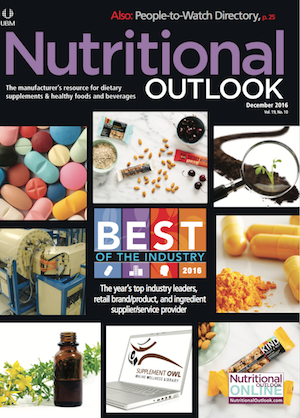Nutritional Outlook's 2016 Best of the Industry, Ingredient Supplier/Service Provider: Sabinsa Corp.
By leading the charge on carbon-dating curcumin, the supplier is helping to guard the natural-curcumin supply chain from adulteration.
Photo © Shutterstock.com/Sophie James

Curcumin is one of the bestselling herbal ingredients in the supplements market today. It is now the top-ranked herb in the U.S. natural channel, with $37 million in sales in that channel alone last year, according HerbalGram’s annual U.S. herbal-supplement sales report. To some unscrupulous actors, those fortunes are just too big to ignore. As demand for curcumin has increased dramatically in recent years, so have cases of curcumin adulteration-namely, the undetected spiking of natural curcumin with synthetic curcumin for economic gain.
For consumers, this is indeed bad news because there is no evidence to show that synthetic curcumin provides any of the health benefits that researchers ascribe to natural curcumin. And for ingredient suppliers invested in natural curcumin, synthetic curcumin threatens their very business, including the integrity of the supply chain and consumer trust in the ingredient as a whole.
Curcumin expert Sabinsa Corp. (East Windsor, NJ) saw this problem unfolding more than five years ago, and the company did something about it. To start with, Sabinsa began suing others it alleged were adulterating natural curcumin with synthetic. Sabinsa made no secret of these lawsuits either, shining a spotlight on the growing problem of adulteration in the curcumin marketplace, which the company says has now been detected in the U.S., Europe, and Australia.
Then the company turned its attention to testing. Unfortunately, test methods like chromatography (HPLC, etc.) or spectral analysis cannot distinguish synthetic curcumin from natural curcumin. In the case of HPLC, for instance, synthetic curcumin replicates the same chromatogram “peaks” that register with natural curcumin, making it impossible to tell the difference. Radiocarbon dating, however, can distinguish between natural and synthetic materials.
Knowing this, in 2011, Sabinsa reached out to the University of Georgia’s Center for Applied Isotope Studies (CAIS; Athens, GA), which had developed advanced technologies around carbon dating. “As a science-based company with over 100 scientists on staff, we were very much aware of the trailblazing research work done by CAIS on the differences in isotopic composition between natural products and petroleum-based synthetic products,” says N. Kalyanam, PhD, Sabinsa’s president of R&D.
Carbon dating can detect synthetic curcumin where other testing techniques fail because it tests for carbon 14 (14C), a radioactive isotope inherent in plants. Plants naturally absorb carbon dioxide from the atmosphere during photosynthesis and thus contain traces of 14C; ingredients produced in a lab and not in nature, however, will not contain 14C. By carbon dating, scientists can look for the presence of 14C to indicate that a sample is of natural origin.
Talk about carbon dating may bring back memories of high school science class, but the technology is actually far more advanced today, Kalyanam explains. For instance, researchers no longer focus on carbon dating by way of measuring the amount of radioactivity using a liquid scintillation counting instrument. Instead, researchers like CAIS use sophisticated mass spectral equipment-namely, an accelerator mass spectrometer (AMS), Kalyanam explains. The AMS is more accurate and works faster than liquid scintillation counters. In fact, he says, the AMS that CAIS uses is so accurate that it can still detect 14C even if there is actually less 14C in the atmosphere today compared to years ago. He notes an interesting fact: “If you submit two natural curcuminoids samples, one manufactured in 2011 and one recently in 2016, CAIS will easily distinguish one from the other, even though these two samples will be indistinguishable by every other known analytical method.”

Caption: This University of Georgia 500KeV accelerator mass spectrometer can be used to identify synthetic curcumin. Photo from Sabinsa Corp.
Not only that, he says, but “CAIS can exactly detect the extent of synthetic contamination.” This means that even if there are only trace amounts of synthetic curcumin present in a natural sample (for instance, even a 2:98 ratio of synthetic:natural), the “CAIS method can still unfailingly determine even this low level of contamination,” Kalyanam says.
This summer, Sabinsa announced that it will use carbon testing on all batches of Curcumin C3 Complex, the supplier’s flagship branded and highly studied curcumin ingredient. The company says it is doing this to “safeguard customer and consumer confidence in their product.”
At least one other curcumin-ingredients supplier is now working with CAIS on carbon dating. Kalyanam says Sabinsa welcomes the company. “Sabinsa was the first natural ingredients supplier to seek this testing from [CAIS],” he says. “Sabinsa is proud to be the torchbearer on this important fight against adulteration. We are happy to learn that other companies are following our lead to eradicate synthetic curcumin contamination in this exploding curcuminoids market.”
Other 2016 winners:
Nutritional Outlook's 2016 Best of the Industry, Industry Leader: Council for Responsible Nutrition
Nutritional Outlook's 2016 Best of the Industry, Industry Leader: Botanical Adulterants Program
Nutritional Outlook's 2016 Best of the Industry, Retail Brand/Product: KIND
Also read:
Radiocarbon Provides “Conclusive Test” for Detecting Synthetic Curcumin, Sabinsa Says
Turmeric Rising: Turmeric and Curcumin Research Is Hot


.png&w=3840&q=75)

.png&w=3840&q=75)



.png&w=3840&q=75)



.png&w=3840&q=75)





















